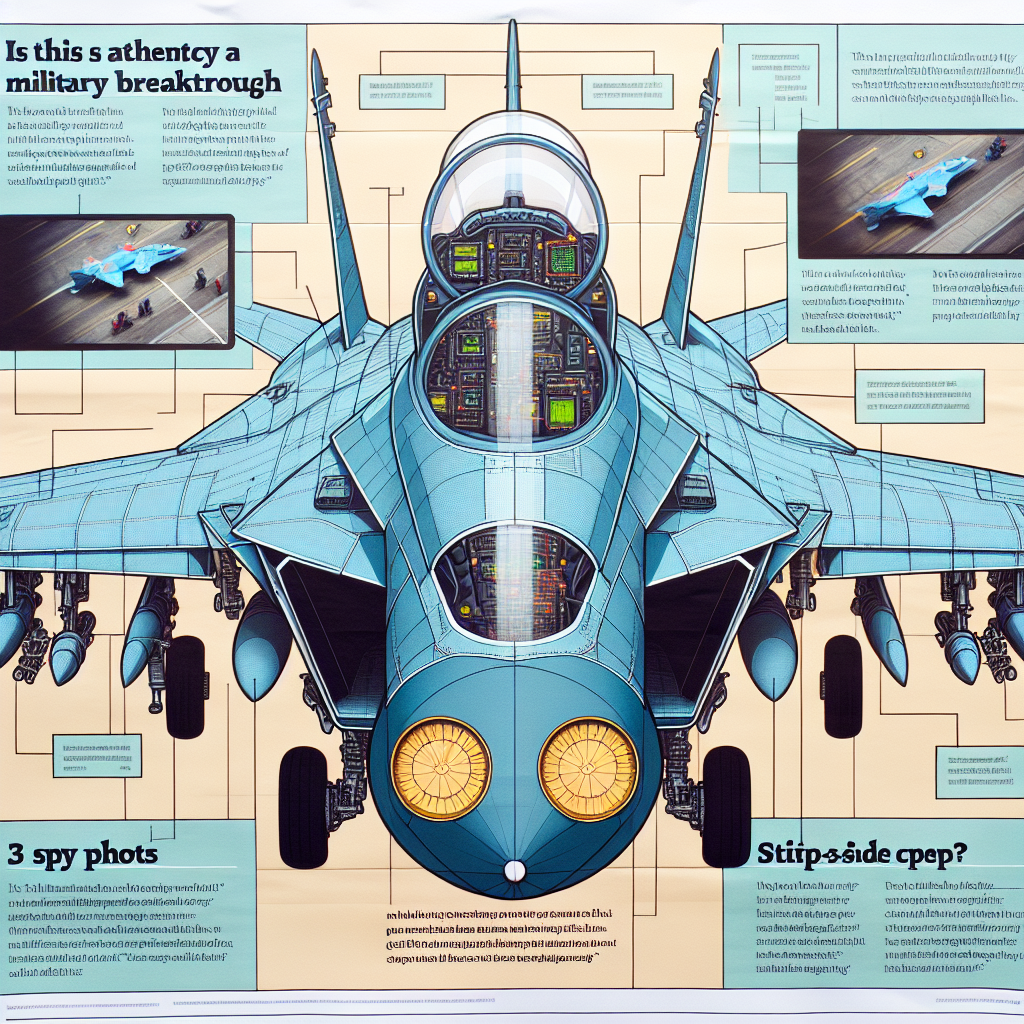Recent exposure of the J-36 fighter aircraft, with three air intakes and three engines, equipped with a heads-up display and side-by-side cockpit design, CCTV “accidentally” confirmed the authenticity of spy photos. Is this a military breakthrough or just a stopgap measure?
Recently, the latest spy photos of the so-called sixth-generation fighter J-36 of the Chinese Communist Party have been exposed online. This is the clearest frontal view released so far, showcasing the overall design of the J-36. The J-36 adopts a side-by-side dual-seat cockpit layout, similar to the Russian Su-34 Fullback fighter-bomber, with three weapon bays in the fuselage, one large weapon bay, and two small weapon bays on the sides.
Many viewers may have mixed feelings upon seeing these spy photos, particularly with the flat and elongated nose of the aircraft, along with its spacious cockpit, resembling a certain creature. The appearance of the J-36 cannot be compared to the F-22 or F-14, and even the Su-27 series has more elegant lines.
When many questioned the authenticity of the spy photos, CCTV came forward. CCTV released a news on Weibo, stating that a freelance journalist, Wei, captured sensitive military facilities from a distance using a telephoto lens while visiting a tourist site, and posted the photos on social media. He was eventually handled according to the law.
This confirms that the spy photos we saw are indeed authentic.
Moreover, the satellite images of the Chengdu Aircraft Factory surrounding area in the photos match the background of the images, indicating that the hangar is specifically built for the J-36.
Just last month, another set of spy photos of the J-36 appeared, showing the aircraft during takeoff and landing, although the images were slightly blurry. Nonetheless, we can clearly see the third engine at the rear and the large air intake under the J-36’s nose. Additionally, there is a large aperture optical window on the lower side of the J-36’s nose that reflects sunlight in low-angle light conditions. This equipment is likely a similar optical device to the US F-35’s EOTS.
So, what technological features do these spy photos reveal about the J-36? Is the J-36 really a sixth-generation aircraft?
Firstly, the J-36 utilizes a side-by-side cockpit design. This layout is reminiscent of the Russian Su-34 “Fullback” fighter-bomber. It offers several advantages, such as easier communication between the two pilots and improved visibility for the co-pilot. The side-by-side cockpit provides ample space, allowing for more freedom of movement. Similar to the Su-34, there is a small passage behind the seats for pilots to stand, stretch their bodies, eat, or take a brief rest during long missions. This is important as the Su-34’s mission durations can extend for hours or even more, necessitating adequate rest for the pilots.
Generally, only large bombers feature side-by-side cockpits, such as US strategic bombers like the B-2 or B-1B Lancer.
However, this design also has significant drawbacks. The side-by-side layout is wider than a tandem one, increasing the radar cross-section. Additionally, the larger cockpit canopy creates more aerodynamic drag, affecting supersonic flight. Hence, such designs are rare on fighter aircraft.
Based on the side-by-side cockpit design, it is evident that the J-36 is intended for ground and sea combat, rather than as an air superiority fighter.
The second technological feature is the J-36’s use of a HUD head-up display. In the spy photos, the large cockpit features two green glowing spots, which are actually special glass panels serving as the HUD, providing critical parameters to the pilot without the need to look down at instruments.
The latest display technology is the Helmet-Mounted Display (HMD), which projects combat information onto the helmet visor, allowing for look-and-shoot capabilities. The US aircraft like the F-15, F-16, F-18 use colored HUDs, while the F-35 employs advanced HMDs. China’s J-20 has also upgraded its HMD system in recent years.
The third feature revealed by the spy photos is the internal weapon bays. The J-36 has two large weapon bays visible underneath the fuselage, each with two bay doors, as well as a smaller bay door on the side, confirming a total of four weapon bays. The two large bays are likely for anti-ship missiles, while the smaller side bays could house air-to-air weaponry.
The fourth highlighted feature is the size of the air intakes. The J-36 utilizes a design with three air inlets, two below the fuselage and an extremely large DSI intake on the back, impressively close in size to the entire width and height of the cockpit. This contrasts with the B-21’s small engine intakes, showcasing a significant difference in design philosophy.
From these design features, the so-called “sixth-generation fighter J-36” appears to be more of a fighter-bomber than a pure sixth-generation aircraft. The J-36’s actual role seems more in line with a fifth-generation strike fighter, akin to an upgraded Su-34 Fullback. It may address certain gaps in the Chinese Air Force but still has a long way to go to be considered a true sixth-generation aircraft.
The development of the J-36 seems to fill the gap left by the delayed progress of the original fifth-generation bomber project, H-20. With China’s aircraft engine technology lagging, the J-36’s need for three engines indicates possible propulsion constraints. The J-36, although smaller in size compared to the US B-21, likely has a payload capacity around 40 to 50 tons, falling short compared to the B-21 and facing challenges in stealth capabilities.
In essence, the “sixth-generation fighter J-36” by Chengdu Aircraft appears to be more of an interim measure to bolster the Chinese Air Force’s long-range strike capability while awaiting the H-20 program’s progress. Its true role seems to be that of a fifth-generation strike fighter rather than a genuine sixth-generation aircraft, serving as an updated version of the Su-34 Fullback. It may supplement certain scenarios within the Chinese Air Force but lacks the advancements that define a full-fledged sixth-generation aircraft.
Subscribe to “Military Intelligence” YouTube channel:
https://www.youtube.com/@MilitaryIntelligence999/featured
Subscribe to GJW channel:
https://www.ganjingworld.com/channel/1eiqjdnq7go7Rbr3gcLeMtv0n13p0c
Subscribe to Instagram:
https://www.instagram.com/tansuoshifen/
Donation link:
https://donorbox.org/tssf

